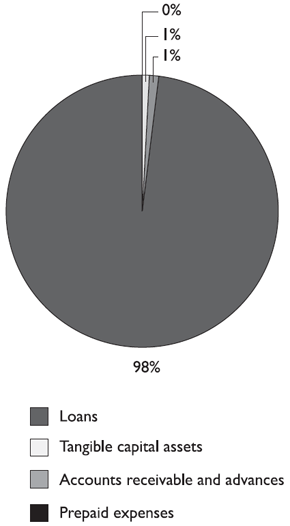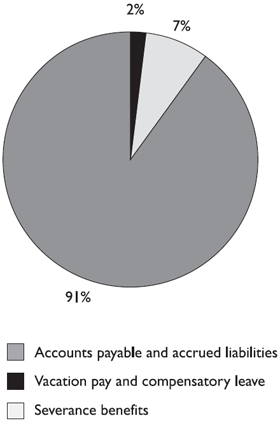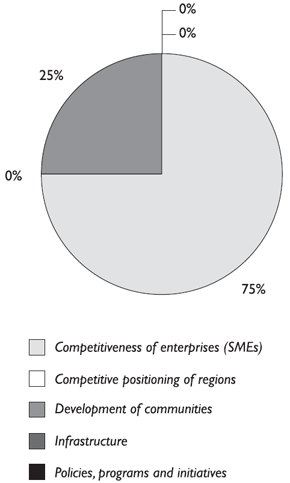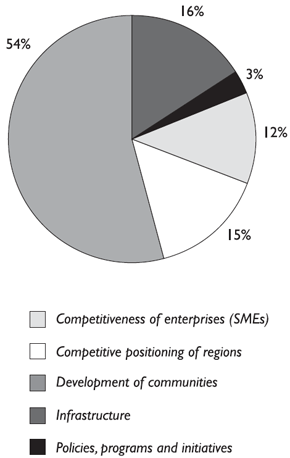Common menu bar links
Breadcrumb Trail
ARCHIVED - Economic Development Agency of Canada for the Regions of Quebec
 This page has been archived.
This page has been archived.
Archived Content
Information identified as archived on the Web is for reference, research or recordkeeping purposes. It has not been altered or updated after the date of archiving. Web pages that are archived on the Web are not subject to the Government of Canada Web Standards. As per the Communications Policy of the Government of Canada, you can request alternate formats on the "Contact Us" page.
3 Additional Information
3.1 Financial highlights
The financial highlights presented in this report are intended to provide a general overview of the Agency’s operations and financial situation. The detailed financial statements for 2007-2008 can be found on the Agency Website.49
The additional information presented in the previous financial tables was prepared on a cash basis and in the following financial statements on an accrual basis, with tables reconciling these two accounting methods also presented.
| Financial Highlights | |||
|---|---|---|---|
| (in thousands of dollars) | Percentage variance | 2008 | 2007 |
| For the period ending March 31: Summary of financial situation | |||
| Assets | |||
| Total assets | - 3 % | 156,476 | 160,849 |
| TOTAL | - 3 % | 156,476 | 160,849 |
| Liabilities | |||
| Total liabilities1 | 122 % | 93,087 | 41,852 |
| Equity | |||
| Total equity | - 47 % | 63,389 | 118,997 |
| TOTAL | - 3 % | 156,476 | 160,849 |
| For the period ending March 31: Summary of results | |||
| Expenditures | |||
| Total expenditures | - 6 % | 312,662 | 332,374 |
| Revenue | |||
| Total revenues2 | - 55 % | 669 | 1,497 |
| Net operating costs | - 6 % | 311,993 | 330,877 |
1 The increase in liabilities is primarily attributable to year-end payables ($30.1 million at March 31, 2007, and $66.2 million at March 31, 2008).
2 Revenue is primarily composed of revenues from interest. At March 31, 2007, the level of revenues was higher than the normal average.

- Total assets of $156 million at the close of 2007-2008
- Down 3% from 2006-2007
- Loans account for 98% of the Agency’s assets, or $153 million
- Accounts receivable represent 0.64% and tangible capital assets 1.36% of the total assets of the Agency

- Total liabilities of $93 million at the close of 2007-2008, up 122% over 2006-2007
- Payables of $85 million, vacation pay $2 million and compensatory leave $6 million
- At $85 million, accounts payable represent the largest share (91%) of liabilities
- Revenues are entered at the time of billing of interest and repayments above 100%

- Revenues composed primarily of interest ($497,000)
- Total sales revenues of $669,000
Expenses

- Total expenses of $313 million in 2007-2008
- The majority of funds, or $170 million, used for development of Canada’s communities
- $50 million for Infrastructure
- $47 million for Competitive positioning of regions
- $36 million for Competitiveness of enterprises (SMEs)
- $10 million for Policies, programs and initiatives
3.2 Tables in electronic format posted on the Treasury Board Secretariat Website
The following tables can be found on the TBS Website: www.tbs-sct.gc.ca/dpr-rmr/st-ts-eng.asp
Table 4: Sources of non-respendable revenue
Illustrates revenue and provides an historical perspective. Revenue consists primarily of repayments of the repayable contributions awarded by the Agency.
Table 6A: User Fees Act
Lists all of the user fees.
Table 6B: Policy on service standards for external fees
In line with the Policy on service standards for external fees, the table presents the latest performance results and main events or plans regarding stakeholder consultation.
Table 9: Details on transfer payment programs
Reports on transfer payment program (TPP) performance in relation to the commitments and expected outcomes identified in the 2007-2008 RPP for transfers exceeding $5 million.
Table 12: Sustainable Development Strategy
Presents the state of advancement of commitments made since implementation of the SDD and expected departmental outcomes as stated in the 2007-2008 RPP.
Table 13: Response to parliamentary committees, audits and evaluations
Provides a list of responses to parliamentary committee reports, reports of the Auditor General of Canada and external audit reports concerning the Agency’s activities in 2007-2008.
Table 14: Internal audits and evaluations
Lists all of the internal evaluations and audits conducted, with hyperlinks to their reports.
3.3 Other topics of interest
Promoter satisfaction
Performance results on promoter satisfaction regarding Agency services.
The table can be found on the Agency Website:
www.dec-ced.gc.ca/eng/publications/agency/rmr.html
4 Appendices
The appendices can be found on the Agency Website: www.dec-ced.gc.ca/eng/publications/agency/rmr.html
Appendix 1: List of the seven regions and 21 devitalized RCMs
Appendix 2: Agency performance measurement methodology
Appendix 3: Technical notes on result tables
Appendix 4: List of acronyms
Appendix 5: Agency business offices
Appendix 6: Resource-person and statute administered
1 See Appendix 1 for the list of seven devitalized regions and 21 devitalized RCMs: www.dec-ced.gc.ca/asp/Publications/Doc_pub_agence.asp?LANG=EN#RMR2
2 www.tbs-sct.gc.ca/est-pre/20072008/me-bd/pub/ME-002_e.asp
3 This information shows whether 2007-2008 efforts were consistent with established priorities. Given that the Program Activity Architecture covers a wide range of types of intervention, it is important that the Agency make judicious choices regarding investment targets. The variation in budget intensity indicator measures the Agency’s capacity for exercising its mandate according to the priorities it has set. Its calculation is based on the difference between the strategic outcome’s total share of actual spending in 2007-2008 versus its total share of actual spending in 2006-2007. Total spending excludes the Infrastructure program activity.
4 The leverage effect is obtained by dividing total cost of projects (at approval) by total funding authorized by the Agency.
5 See Appendix 1 for the list of seven devitalized regions and 21 devitalized RCMs: www.dec-ced.gc.ca/asp/Publications/Doc_pub_agence.asp?LANG=EN#RMR2
6 Actual spending may include expenditures in the seven regions and 21 RCMs under the Competitiveness of SMEs and regions strategic outcome.
7 Total spending includes operating expenditures and grants and contributions spending.
8 See Section 2 for detailed information on the results obtained.
9 Section 2 makes the link with Government of Canada performance - www.tbs-sct.gc.ca/report/govrev/06/cp-rc04-eng.asp. The Agency targets the economic diversification of Quebec’s devitalized regions and the sectoral competitiveness of SMEs and regions in order to bring about improved quality of life and a higher standard of living for Canadians.
10 The $51.5 million variance between planned ($100.1 million) and actual ($48.6 million) spending is attributable to the carry-over of promoters’ expense claims to the following year.
11 The Canadian Apparel and Textiles Program (CANtex) used to be considered a special intervention measure. In 2007-2008, the Agency recorded its interventions under this program ($8 million) under Competitiveness of enterprises (SMEs).
12 This information shows whether 2007-2008 efforts were consistent with established priorities. Given that the Program Activity Architecture covers a wide range of types of intervention, it is important that the Agency make judicious choices regarding investment targets. The variation in budget intensity indicator therefore measures the Agency’s capacity for exercising its mandate according to the priorities it has set. Its calculation is based on the difference between the strategic outcome’s total share of actual spending in 2007-2008 versus its total share of actual spending in 2006-2007. Total spending excludes the Infrastructure program activity.
13 The leverage effect is obtained by dividing total cost of projects (at approval) by total funding authorized by the Agency.
14 Total spending includes operating expenditures and grants and contributions spending.
15 See Section 2 for detailed information on the results obtained.
16 Section 2 makes the link with Government of Canada performance - www.tbs-sct.gc.ca/report/govrev/06/cprc04-eng.asp. The Agency targets the economic diversification of Quebec’s devitalized regions and the sectoral competitiveness of SMEs and regions in order to bring about improved quality of life and a higher standard of living for Canadians.
17 This information shows whether 2007-2008 efforts were consistent with established priorities. Given that the Program Activity Architecture covers a wide range of types of intervention, it is important that the Agency make judicious choices regarding investment targets. The variation in budget intensity indicator measures the Agency’s capacity for exercising its mandate according to the priorities it has set. Its calculation is based on the difference between the strategic outcome’s total share of actual spending in 2007-2008 versus its total share of actual spending in 2006-2007. Total spending excludes the Infrastructure program.
18 Total spending includes operating expenditures and grants and contributions spending.
19 See Section 2 for detailed information on the results obtained.
20 Section 2 makes the link with Government of Canada performance - www.tbs-sct.gc.ca/report/govrev/06/cprc04-eng.asp. The Agency targets the economic diversification of Quebec’s devitalized regions and the sectoral competitiveness of SMEs and regions in order to bring about improved quality of life and a higher standard of living for Canadians.
21 www.dec-ced.gc.ca/asp/Publications/Doc_pub_agence.asp?
LANG=EN&SEL_MENU=PUB_AGE& FICHIER_RETOUR=doc_pub_agence.asp
22 To view the Management Accountability Framework: www.tbs-sct.gc.ca/maf-crg/index_e.asp
23 www.tbs-sct.gc.ca/est-pre/20072008/me-bd/pub/ME-002_e.asp
24 These amounts exclude the Infrastructure program activity, the results of which are presented in Section 2.1.2.
25 This information shows whether 2007-2008 efforts were consistent with established priorities. See Appendix 3: www.dec-ced.gc.ca/asp/Publications/Doc_pub_agence.asp?LANG=EN#RMR2
26 Excludes jobs created and maintained through the CFP.
27 www.dec-ced.gc.ca/asp/Publications/Doc_pub_agence.asp?LANG=EN#RMR2
28 www.dec-ced.gc.ca/asp/Publications/Doc_pub_agence.asp?LANG=EN#RMR2
29 See Appendix 1 for the list of seven devitalized regions and 21 devitalized RCMs: www.dec-ced.gc.ca/asp/Publications/Doc_pub_agence.asp?LANG=EN#RMR2
30 This amount excludes operating costs.
31 www.dec-ced.gc.ca/asp/Publications/Doc_pub_agence.asp?
LANG=EN&SEL_MENU=PUB_AGE& FICHIER_RETOUR=doc_pub_agence.asp
32 www.dec-ced.gc.ca/asp/SalleNouvelles/communiques.asp?
LANG=EN&TYPE_COMM=COMM&PRESS_ RELEASE_ID=4778
33 Info entrepreneurs and Resources Entreprises satellite centres.
34 This average excludes jobs created or maintained through NPOs. See Appendix 3 for the methodology used in this calculation: www.dec-ced.gc.ca/asp/Publications/Doc_pub_agence.asp?LANG=EN#RMR2
35 A Canada-Quebec Agreement concerning Infrastructure programs.
36 www.infrastructure.gc.ca/index_e.shtml
37 Number of projects not completed as of March 31, 2008.
38 Benefits from the 896 projects approved since implementation of the ICP.
39 This information shows whether 2007-2008 efforts were consistent with established priorities. See Appendix 3: www.dec-ced.gc.ca/asp/Publications/Doc_pub_agence.asp?LANG=EN#RMR2
40 Study of eight incubators funded by the Agency.
41 The Canadian Apparel and Textiles Program (CANtex) used to be considered a special intervention measure. In 2007-2008, the Agency transferred the 10 FTEs under this program to Competitiveness of enterprises (SMEs).
42 www.dec-ced.gc.ca/asp/Publications/Doc_pub_agence.asp?LANG=EN#RMR2
43 Includes ORPEXs.
44 www.dec-ced.gc.ca/asp/Publications/Doc_pub_agence.asp?
LANG=EN&SEL_MENU=PUB_AGE&FICHIER_ RETOUR=doc_pub_agence.asp
45 Taux de survie des nouvelles entreprises au Québec, 2008 Edition. Direction de l’analyse économique, Direction générale des politiques et des sociétés d’État, Ministčre du Développement économique, de l’Innovation et de l’Exportation du Québec (MDEIE), May 2008.
46 This information shows whether 2007-2008 efforts were consistent with established priorities. See Appendix 3: www.dec-ced.gc.ca/asp/Publications/Doc_pub_agence.asp?LANG=EN#RMR2
47 The international organizations include: Finance Alliance for Sustainable Trade, the International Federation of Interior Architect and Designers and the Global Campaign on Climate.
48 This information shows whether 2007-2008 efforts were consistent with established priorities. If the rate is up, for example, it means the Agency invested more in this component. Its calculation is based on the difference between the strategic outcome’s total share of actual spending in 2007-2008 versus its total share of actual spending in 2006-2007. Total spending excludes the Infrastructure program activity.
49 www.dec-ced.gc.ca/asp/Publications/Doc_pub_agence.asp?LANG=EN#RMR2
